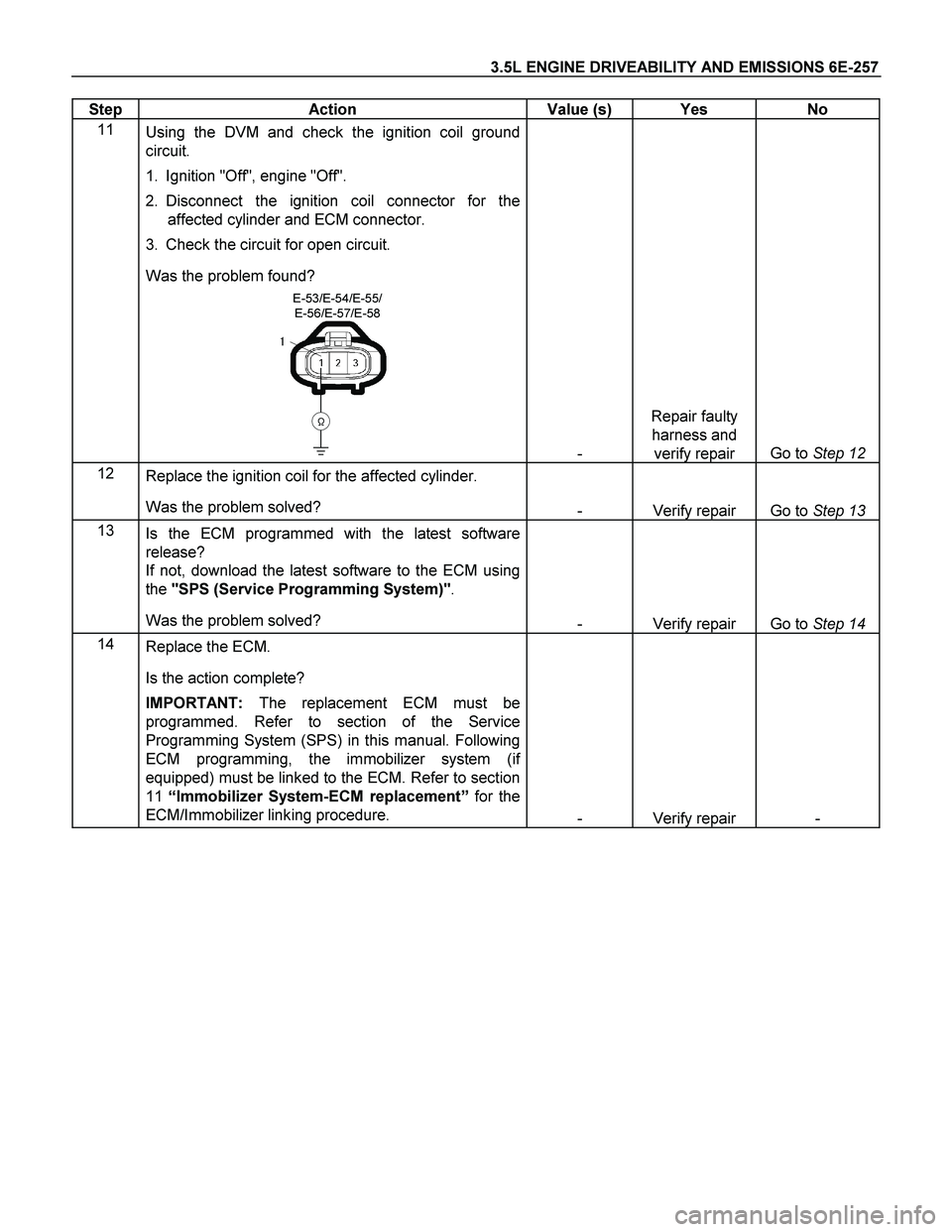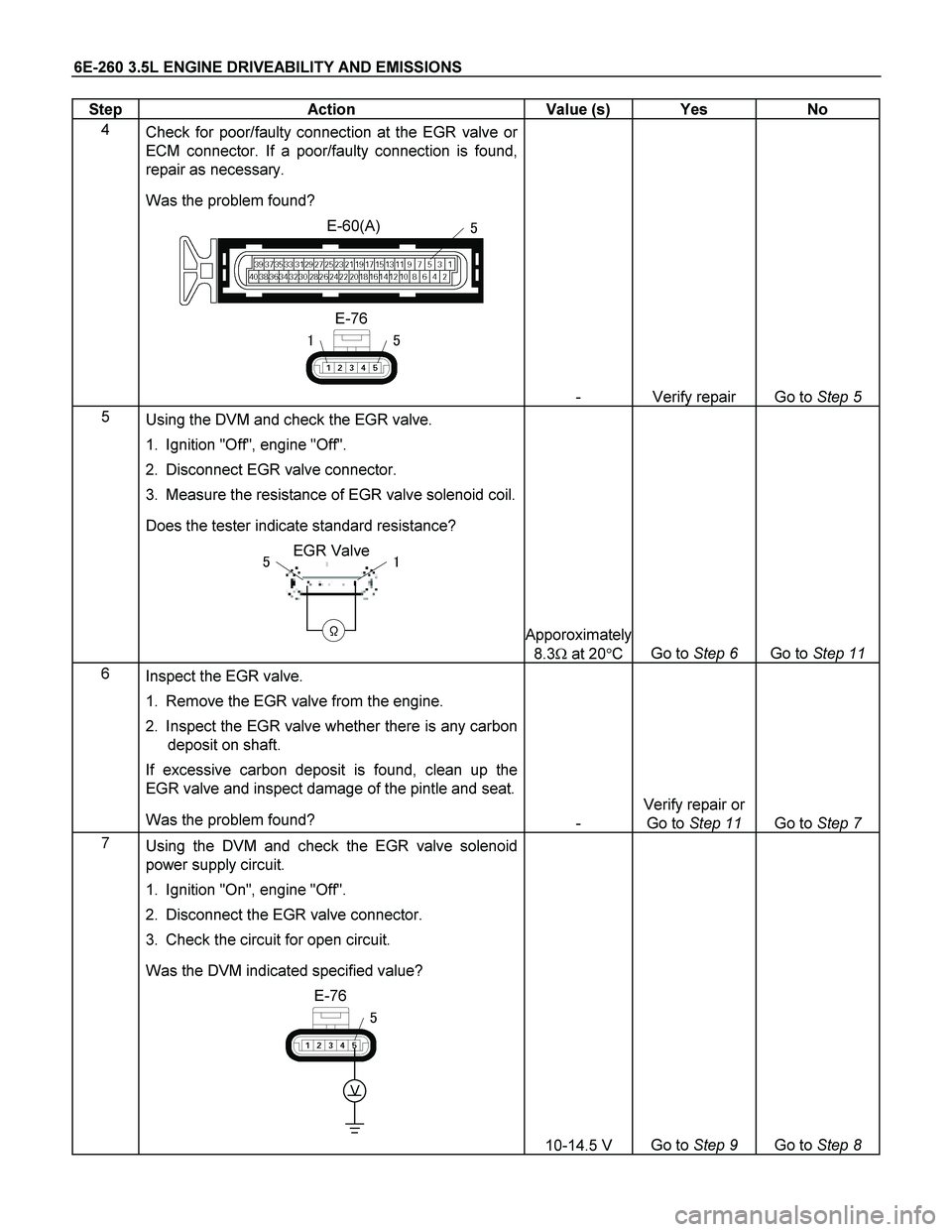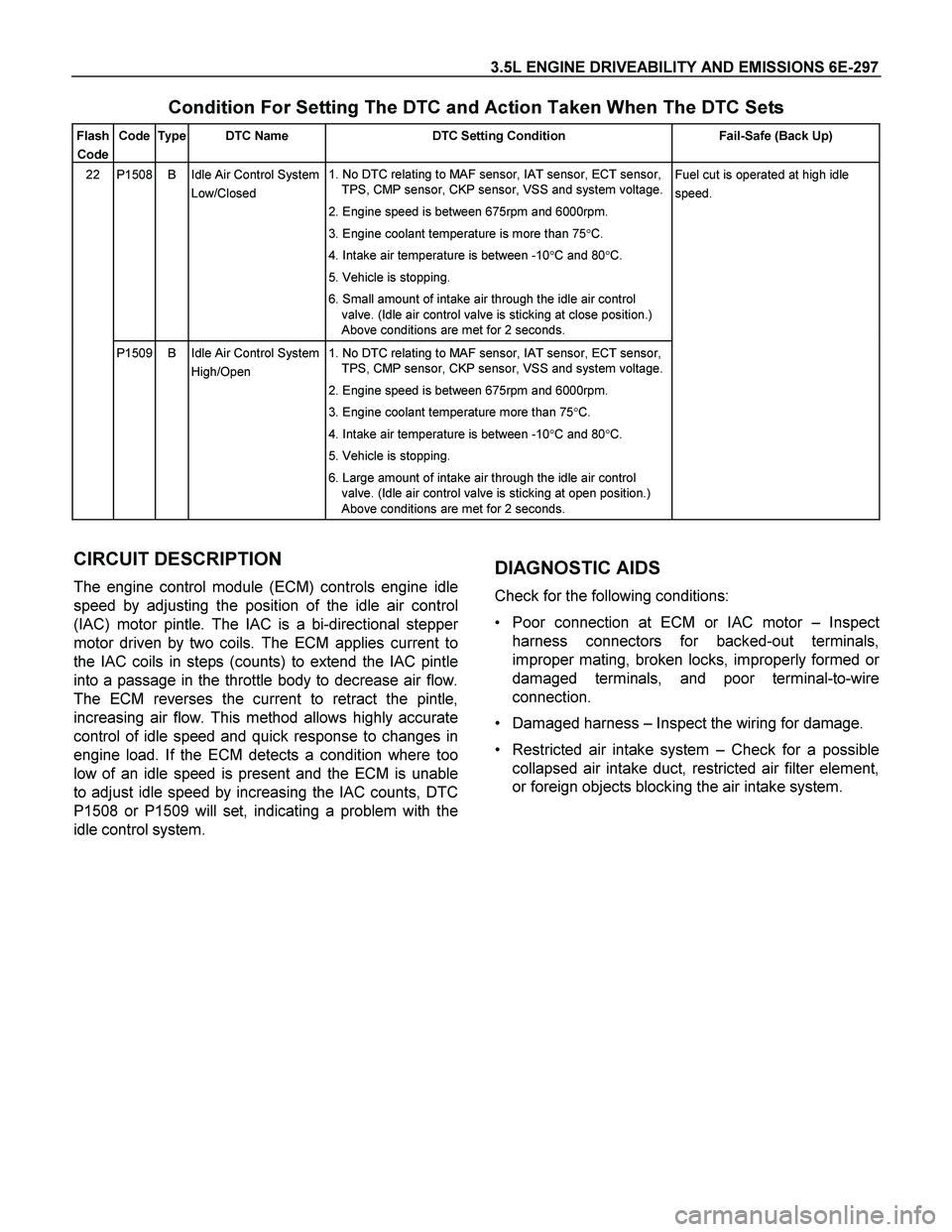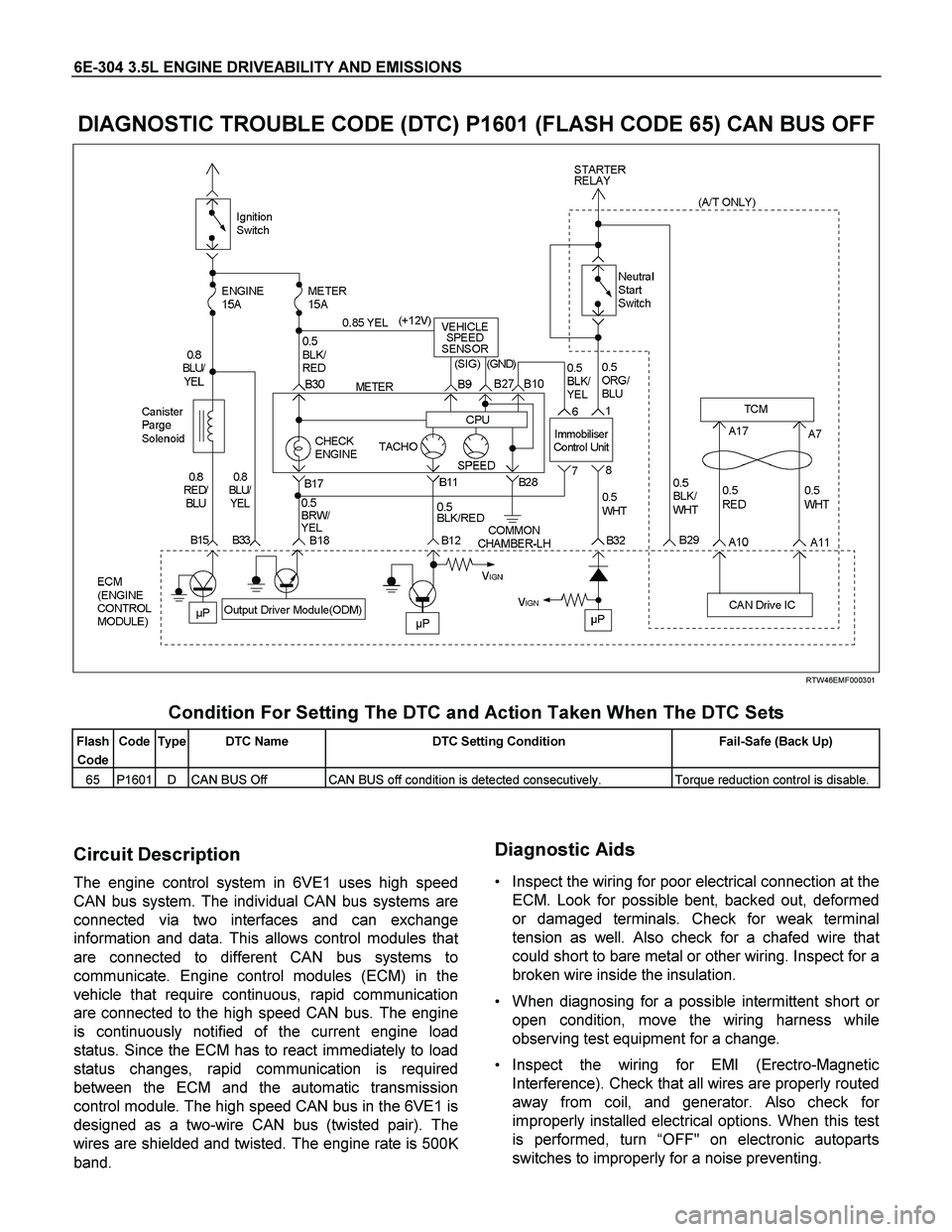Page 2252 of 4264
6E-256 3.5L ENGINE DRIVEABILITY AND EMISSIONS
Step Action Value (s) Yes No
8
Using the DVM and check the ignition coil power
supply circuit.
1. Ignition "On", engine "Off".
2. Disconnect the ignition coil connector for the
affected cylinder.
3. Check the circuit for open circuit.
Was the DVM indicated specified value?
E-53/E-54/E-55/
E-56/E-57/E-58
V
�
10-14.5V
Go to Step 10
Go to Step 9
9
Repair the open or short to ground circuit between the
"IGN. COIL" (15A) and ignition coil for the affected
cylinder.
Is the action complete?
- Verify repair -
10
Using the DVM and check the ignition coil ground
circuit for the affected cylinder.
1. Ignition "On", engine "Off".
2. Disconnect the ignition coil connector for the
affected cylinder.
3. Check the circuit for short to power supply circuit.
Was the DVM indicated specified value?
E-53/E-54/E-55/
E-56/E-57/E-58
V
�
Less than 1V
Go to Step 11
Repair faulty
harness and
verify repair
Page 2253 of 4264

3.5L ENGINE DRIVEABILITY AND EMISSIONS 6E-257
Step Action Value (s) Yes No
11
Using the DVM and check the ignition coil ground
circuit.
1. Ignition "Off", engine "Off".
2. Disconnect the ignition coil connector for the
affected cylinder and ECM connector.
3. Check the circuit for open circuit.
Was the problem found?
E-53/E-54/E-55/
E-56/E-57/E-58
�
�
- Repair faulty
harness and
verify repair Go to Step 12
12
Replace the ignition coil for the affected cylinder.
Was the problem solved?
- Verify repair Go to Step 13
13
Is the ECM programmed with the latest software
release?
If not, download the latest software to the ECM using
the "SPS (Service Programming System)".
Was the problem solved?
- Verify repair Go to Step 14
14
Replace the ECM.
Is the action complete?
IMPORTANT: The replacement ECM must be
programmed. Refer to section of the Service
Programming System (SPS) in this manual. Following
ECM programming, the immobilizer system (if
equipped) must be linked to the ECM. Refer to section
11 “Immobilizer System-ECM replacement” for the
ECM/Immobilizer linking procedure.
- Verify repair -
Page 2256 of 4264

6E-260 3.5L ENGINE DRIVEABILITY AND EMISSIONS
Step Action Value (s) Yes No
4
Check for poor/faulty connection at the EGR valve or
ECM connector. If a poor/faulty connection is found,
repair as necessary.
Was the problem found?
E-60(A)
E-76
�
��
- Verify repair Go to Step 5
5
Using the DVM and check the EGR valve.
1. Ignition "Off", engine "Off".
2. Disconnect EGR valve connector.
3. Measure the resistance of EGR valve solenoid coil.
Does the tester indicate standard resistance?
EGR Valve
�
��
Apporoximately
8.3� at 20�C
Go to Step 6
Go to Step 11
6
Inspect the EGR valve.
1. Remove the EGR valve from the engine.
2. Inspect the EGR valve whether there is any carbon
deposit on shaft.
If excessive carbon deposit is found, clean up the
EGR valve and inspect damage of the pintle and seat.
Was the problem found?
-
Verify repair or
Go to Step 11
Go to Step 7
7
Using the DVM and check the EGR valve solenoid
power supply circuit.
1. Ignition "On", engine "Off".
2. Disconnect the EGR valve connector.
3. Check the circuit for open circuit.
Was the DVM indicated specified value?
E-76
V
�
10-14.5 V
Go to Step 9
Go to Step 8
Page 2272 of 4264
6E-276 3.5L ENGINE DRIVEABILITY AND EMISSIONS
Step Action Value (s) Yes No
4
Check for poor/faulty connection at the purge solenoid
valve or ECM connector. If a poor/faulty connection is
found, repair as necessary.
Was the problem found?
E-61(B)
E-66
��
��
- Verify repair Go to Step 5
5
Using the DVM and check the purge solenoid valve.
1. Ignition "Off", engine "Off".
2. Disconnect purge solenoid valve connector.
3. Measure the resistance of purge solenoid valve
coil.
Does the tester indicate standard resistance?
25 - 30� at
20�C
Go to Step 6
Go to Step 9
6
Using the DVM and check the purge solenoid valve
power supply circuit.
1. Ignition "On", engine "Off".
2. Disconnect the purge solenoid valve connector.
3. Check the circuit for open circuit.
Was the DVM indicated specified value?
E-66
V
�
10-14.5V
Go to Step 8
Go to Step 7
7
Repair the open or short to ground circuit between the
"Engine" fuse (15A) and purge solenoid valve.
Is the action complete?
- Verify repair -
Page 2293 of 4264

3.5L ENGINE DRIVEABILITY AND EMISSIONS 6E-297
Condition For Setting The DTC and Action Taken When The DTC Sets
Flash
Code Code Type DTC Name DTC Setting Condition Fail-Safe (Back Up)
P1508 B Idle Air Control System
Low/Closed 1. No DTC relating to MAF sensor, IAT sensor, ECT sensor,
TPS, CMP sensor, CKP sensor, VSS and system voltage.
2. Engine speed is between 675rpm and 6000rpm.
3. Engine coolant temperature is more than 75�C.
4. Intake air temperature is between -10�C and 80�C.
5. Vehicle is stopping.
6. Small amount of intake air through the idle air control
valve. (Idle air control valve is sticking at close position.)
Above conditions are met for 2 seconds. 22
P1509 B Idle Air Control System
High/Open 1. No DTC relating to MAF sensor, IAT sensor, ECT sensor,
TPS, CMP sensor, CKP sensor, VSS and system voltage.
2. Engine speed is between 675rpm and 6000rpm.
3. Engine coolant temperature more than 75�C.
4. Intake air temperature is between -10�C and 80�C.
5. Vehicle is stopping.
6. Large amount of intake air through the idle air control
valve. (Idle air control valve is sticking at open position.)
Above conditions are met for 2 seconds. Fuel cut is operated at high idle
speed.
CIRCUIT DESCRIPTION
The engine control module (ECM) controls engine idle
speed by adjusting the position of the idle air control
(IAC) motor pintle. The IAC is a bi-directional steppe
r
motor driven by two coils. The ECM applies current to
the IAC coils in steps (counts) to extend the IAC pintle
into a passage in the throttle body to decrease air flow.
The ECM reverses the current to retract the pintle,
increasing air flow. This method allows highly accurate
control of idle speed and quick response to changes in
engine load. If the ECM detects a condition where too
low of an idle speed is present and the ECM is unable
to adjust idle speed by increasing the IAC counts, DTC
P1508 or P1509 will set, indicating a problem with the
idle control system.
DIAGNOSTIC AIDS
Check for the following conditions:
Poor connection at ECM or IAC motor –Inspec
t
harness connectors for backed-out terminals,
improper mating, broken locks, improperly formed o
r
damaged terminals, and poor terminal-to-wire
connection.
Damaged harness – Inspect the wiring for damage.
Restricted air intake system – Check for a possible
collapsed air intake duct, restricted air filter element,
or foreign objects blocking the air intake system.
Page 2295 of 4264
3.5L ENGINE DRIVEABILITY AND EMISSIONS 6E-299
Step Action Value (s) Yes No
6
Remove the IAC Valve and visually check.
Was the problem found?
- Go to Step 12 Go to Step 7
7
Using the DVM and check the IAC Valve coil at IAC
Valve.
1. Ignition "Off", engine "Off".
2. Disconnect the IAC Valve connector.
3. Check the coil resistance.
Does the tester indicate standard resistance as shown
in the following table?
IAC Valve
��
��
���
�
�
�
Measurement Terminal Resistance (�)
1 - 2 Approximately 50�
2 - 3 Approximately 50�
1 – 3 Approximately 100�
4 - 5 Approximately 50�
5 - 6 Approximately 50�
4 - 6 Approximately 100�
-
Go to Step 8
Go to Step 12
8
Using the DVM and check the IAC Valve power supply
circuit.
1. Ignition "Off", engine "Off".
2. Disconnect the IAC Valve connector and ECM
main relay
3. Check the circuit for open circuit.
Was the problem found?
X-13E-70
�
�
�
�
�
-
Repair faulty
harness and
verify repair
Go to Step 9
Page 2296 of 4264
6E-300 3.5L ENGINE DRIVEABILITY AND EMISSIONS
Step Action Value (s) Yes No
9
Using the DVM and check the IAC Valve circuit.
Breaker box is available:
1. Ignition "Off", engine "Off".
2. Install the breaker box as type B. (ECM connection)
3. Using the Tech 2, ignition "On" and engine "Off".
4. Select the "Miscellaneous Test" and perform the
"IAC Control" in the "IAC System".
5. Operate the Tech 2 in accrodance with procedure.
Does the DVM indicate correct characteristic as
shown in the following table, when the IAC Valve is
operating step by step?
B13B14 Breaker BoxB17 B16
VVVV
Measurement Point IACV steps at 0, 20, 40, � 160 IACV steps at 10, 30, 50, � 150
Coil A High (Breaker Box 53 & GND) Less than 1V Battery voltage
Coil A Low (Breaker Box 56 & GND) Battery voltage Less than 1V
Coil B High (Breaker Box 54 & GND) Less than 1V Battery voltage
Coil B Low (Breaker Box 57 & GND) Battery voltage Less than 1V
Page 2300 of 4264

6E-304 3.5L ENGINE DRIVEABILITY AND EMISSIONS
DIAGNOSTIC TROUBLE CODE (DTC) P1601 (FLASH CODE 65) CAN BUS OFF
RTW46EMF000301
Condition For Setting The DTC and Action Taken When The DTC Sets
Flash
Code Code Type DTC Name DTC Setting Condition Fail-Safe (Back Up)
65 P1601 D CAN BUS Off CAN BUS off condition is detected consecutively. Torque reduction control is disable.
Circuit Description
The engine control system in 6VE1 uses high speed
CAN bus system. The individual CAN bus systems are
connected via two interfaces and can exchange
information and data. This allows control modules tha
t
are connected to different CAN bus systems to
communicate. Engine control modules (ECM) in the
vehicle that require continuous, rapid communication
are connected to the high speed CAN bus. The engine
is continuously notified of the current engine load
status. Since the ECM has to react immediately to load
status changes, rapid communication is required
between the ECM and the automatic transmission
control module. The high speed CAN bus in the 6VE1 is
designed as a two-wire CAN bus (twisted pair). The
wires are shielded and twisted. The engine rate is 500
K
band.
Diagnostic Aids
Inspect the wiring for poor electrical connection at the
ECM. Look for possible bent, backed out, deformed
or damaged terminals. Check for weak terminal
tension as well. Also check for a chafed wire tha
t
could short to bare metal or other wiring. Inspect for a
broken wire inside the insulation.
When diagnosing for a possible intermittent short o
r
open condition, move the wiring harness while
observing test equipment for a change.
Inspect the wiring for EMI (Erectro-Magnetic
Interference). Check that all wires are properly routed
away from coil, and generator. Also check fo
r
improperly installed electrical options. When this test
is performed, turn “OFF" on electronic autoparts
switches to improperly for a noise preventing.